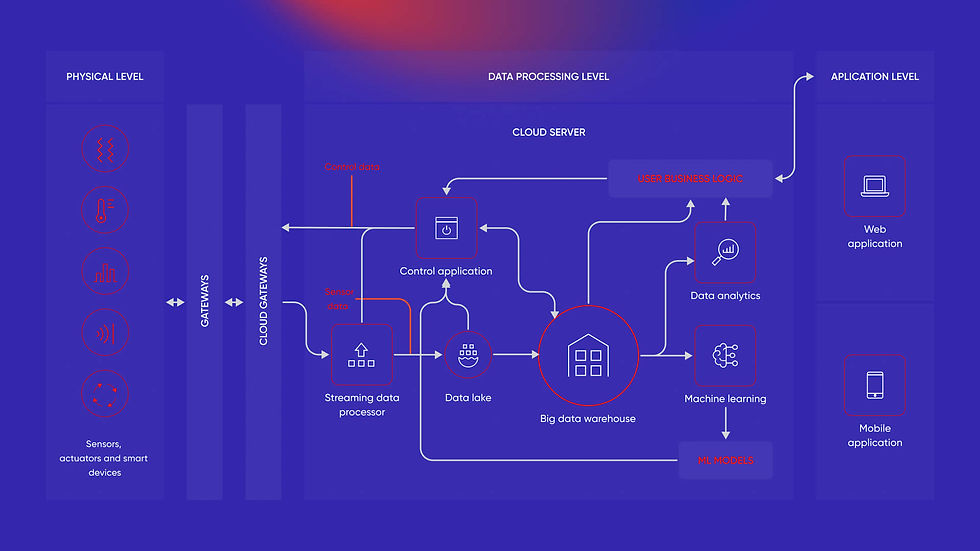How to Build Connected Applications with Angular and IoT Integration
- Muhammad Hassan
- Jan 15
- 4 min read

In the era of smart technology, connected applications are transforming industries by enabling seamless communication between devices. Integrating Angular with IoT (Internet of Things) opens up new possibilities for building dynamic, real-time, and user-friendly applications. This combination leverages the strengths of Angular’s robust frontend framework and IoT’s data-driven ecosystem.
In this article, we’ll explore how to build connected applications using Angular and IoT, the benefits of this integration, and best practices for implementation. Let’s dive in.
Understanding Angular and IoT

What is Angular?
Angular is a popular open-source framework developed by Google for building dynamic web applications. It simplifies the development process by providing features such as two-way data binding, dependency injection, and a powerful CLI (Command Line Interface). An Angular development team can create highly interactive and scalable web applications suitable for various use cases.
What is IoT?
The Internet of Things refers to a network of interconnected devices that communicate and exchange data through the internet. IoT applications are widely used in smart homes, healthcare, agriculture, manufacturing, and more. An IoT development company specializes in building solutions that connect devices, analyze data, and enable automation.
Why Combine Angular with IoT?

1. Real-Time Data Management
IoT generates massive amounts of data in real time. Angular’s reactive architecture is ideal for creating dashboards and interfaces that display this data dynamically, ensuring users always see the latest updates.
2. Enhanced User Experience
Angular’s component-based structure allows developers to create intuitive and responsive user interfaces, which are essential for IoT applications that often involve complex data visualization.
3. Scalability and Flexibility
Combining Angular and IoT enables developers to build scalable applications that adapt to the growing number of connected devices.
Steps to Build Connected Applications with Angular and IoT

1. Define the Application Requirements
Start by identifying the purpose of your IoT application. Consider factors such as:
Type of devices to be connected
Data to be collected and analyzed
User interactions and interfaces
Integration with third-party APIs or services
2. Choose the Right Tools and Technologies
Select tools that align with your project’s goals. Key technologies include:
Frontend Framework: Angular for building the user interface
Backend System: Node.js or Python for managing IoT data
Database: MongoDB or Firebase for storing IoT data
IoT Protocols: MQTT, CoAP, or HTTP for device communication
3. Assemble Your Development Team
Collaborate with an Angular development team and an IoT development company to bring together expertise in frontend development and IoT solutions. This ensures seamless integration and a robust application.
4. Set Up the IoT Infrastructure
Establish the IoT ecosystem by:
Configuring IoT devices and sensors
Setting up gateways for data aggregation
Implementing a cloud-based or on-premises IoT platform to manage data
5. Develop the Angular Application
Build the frontend of your application using Angular. Key steps include:
Creating reusable components for data visualization
Implementing services for API integration
Using RxJS for real-time data handling
6. Integrate IoT Data
Connect the Angular application with the IoT platform by:
Implementing REST APIs or WebSocket connections
Ensuring secure data transfer using encryption protocols
Visualizing data using Angular’s powerful charting libraries like ng2-charts or D3.js
7. Test and Optimize
Thoroughly test the application to identify and fix issues. Optimize performance by:
Minimizing API calls
Using lazy loading for Angular modules
Ensuring efficient memory usage on IoT devices
8. Deploy and Monitor
Deploy the application to your preferred hosting environment. Use monitoring tools to track performance, device connectivity, and user interactions.
Key Features of Angular-IoT Connected Applications

1. Real-Time Dashboards
Angular’s two-way data binding and reactive programming enable the creation of real-time dashboards that display IoT data dynamically.
2. Device Control Interfaces
Develop interfaces that allow users to control IoT devices remotely, such as turning on/off devices or adjusting settings.
3. Data Analytics and Visualization
Leverage Angular’s visualization libraries to present IoT data in meaningful ways, such as graphs, heatmaps, and reports.
4. Notifications and Alerts
Integrate push notifications to alert users about critical events, such as device malfunctions or threshold breaches.
Benefits of Angular-IoT Integration

1. Improved Decision-Making
Real-time data insights empower businesses to make informed decisions, enhancing operational efficiency.
2. Enhanced User Engagement
Interactive and intuitive interfaces built with Angular improve user engagement and satisfaction.
3. Reduced Development Time
Collaboration between an Angular development team and an IoT development company streamlines the development process, reducing time-to-market.
4. Scalability
This integration supports the growth of IoT ecosystems by accommodating an increasing number of devices and users.
Challenges and Solutions

Challenge 1: Security Risks
IoT applications are vulnerable to cyber threats. Mitigate risks by:
Using secure communication protocols
Implementing authentication and authorization mechanisms
Regularly updating software
Challenge 2: Data Overload
Handling large volumes of data can be overwhelming. Address this by:
Implementing data filtering and aggregation techniques
Using cloud storage and edge computing for efficient data management
Challenge 3: Compatibility Issues
Integrating diverse IoT devices can lead to compatibility challenges. Resolve this by:
Adopting standardized IoT protocols
Using middleware for seamless integration
Real-World Examples

1. Smart Home Applications
An Angular-based dashboard allows users to monitor and control smart devices, such as lights, thermostats, and security cameras, enhancing convenience and energy efficiency.
2. Industrial IoT Solutions
Manufacturing companies use Angular and IoT integration to monitor equipment performance, predict maintenance needs, and optimize production processes.
3. Healthcare Monitoring Systems
IoT devices collect patient data, while Angular applications provide healthcare professionals with real-time insights to deliver better care.
Conclusion
Integrating Angular with IoT is a powerful way to build connected applications that are both user-friendly and data-driven. By leveraging the expertise of an Angular development team and an IoT development company, businesses can create scalable solutions that drive innovation and efficiency.
Whether you’re developing smart home systems, industrial IoT solutions, or healthcare applications, the combination of Angular and IoT offers endless possibilities. Embrace this integration to stay ahead in the ever-evolving digital landscape.





Comments